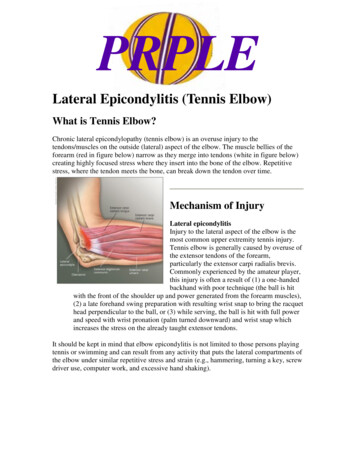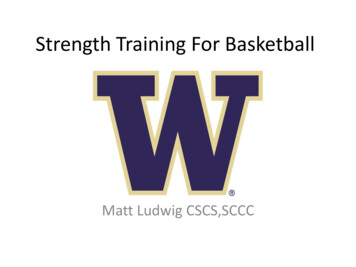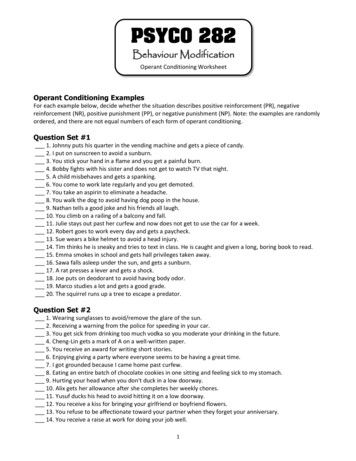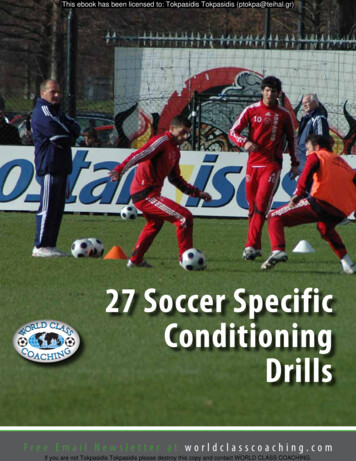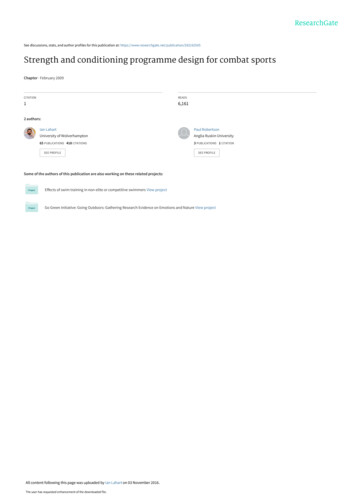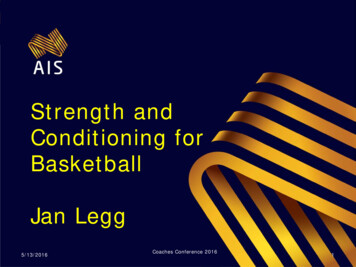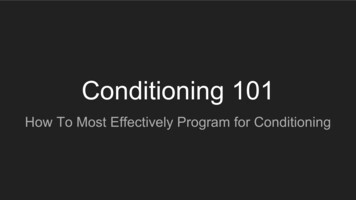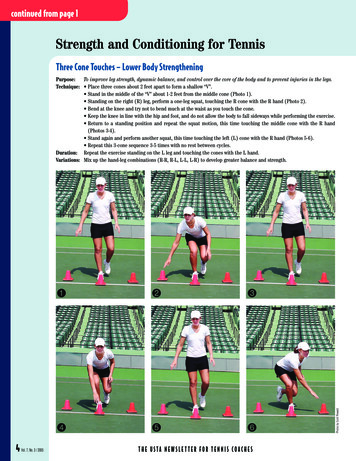
Transcription
continued from page 1Strength and Conditioning for TennisThree Cone Touches – Lower Body Strengthening4 Vol. 7, No. 3 / 2005123456THE USTA NEWSLE TTER FOR TENNIS COACHESPhotos by Scott RiewaldPurpose:To improve leg strength, dynamic balance, and control over the core of the body and to prevent injuries in the legs.Technique: Place three cones about 2 feet apart to form a shallow “V”. Stand in the middle of the “V” about 1-2 feet from the middle cone (Photo 1). Standing on the right (R) leg, perform a one-leg squat, touching the R cone with the R hand (Photo 2). Bend at the knee and try not to bend much at the waist as you touch the cone. Keep the knee in line with the hip and foot, and do not allow the body to fall sideways while performing the exercise. Return to a standing position and repeat the squat motion, this time touching the middle cone with the R hand(Photos 3-4). Stand again and perform another squat, this time touching the left (L) cone with the R hand (Photos 5-6). Repeat this 3-cone sequence 3-5 times with no rest between cycles.Duration: Repeat the exercise standing on the L leg and touching the cones with the L hand.Variations: Mix up the hand-leg combinations (R-R, R-L, L-L, L-R) to develop greater balance and strength.
continued from page 4Strength and Conditioning for TennisSplit Step Lunge with a Twist – Lower Body Strengthening5 Vol. 7, No. 3 / 2005123456THE USTA NEWSLE TTER FOR TENNIS COACHESPhotos by Scott RiewaldPurpose:To improve lower body strength/power, dynamic balance, and core strength.Technique: Starting at the doubles sideline in a standing position, hold a medicine ball in front of the body (Photo 1). After making a split step (Photo 2), step forward with the right (R) leg into a lunge (Photo 3). In the “lunge position,” rotate the body 90 degrees to the left (L) while holding the medicine ball away from the body(Photo 4). Rotate back to the front-facing position (Photo 5) before stepping forward into a standing position (Photo 6). Repeat this series of movements, alternating lunging with the R and L legs, until you reach the other doubles sideline.Note: Always rotate to the side opposite the leg you lunge with.Duration: Lunge from the baseline to the net 1-2 times, taking 30 seconds rest between sets.Cautions: Do not perform this, or any, exercise if it causes knee pain. Do not let the knee come past the toes when performing the lunge. This places added stress on the knee. Before puberty, players should use a 3-6 pound medicine ball. Older players can use medicine balls weighing 8-12pounds.
Quadruped Exercise – Core StrengtheningPurpose:To improve strength and control of the core muscles, particularly in the lower back.Technique: Lay a towel or mat on the court and get down on your hands and knees (Photo 1). Tighten your abdominal and lower back muscles by drawing the belly-button in toward the spine (Photo 1). While keeping a “flat back,” lift the right arm and left leg until they are parallel to the ground (Photo 2). Keep the head in line with the spine by looking down during the exercise. Return to the starting position and repeat while lifting the left (L) arm and right (R) leg (Photo 3).Duration: Perform 2 sets of 15 cycles (both sides) of this exercise.1Photos by Scott Riewald236 Vol. 7, No. 3 / 2005THE USTA NEWSLE TTER FOR TENNIS COACHES
Medicine Ball Throws – Core Strengthening1234THE USTA NEWSLE TTER FOR TENNIS COACHESPhotos by Scott RiewaldPurpose:To develop explosive power using the core of the body and the legs.Technique: In an open stance, stand about 3 feet away from a wall or other hard surface. Facing the wall, hold a medicine ball in both hands (Photo 1). Load the legs and rotate the torso as you prepare to throw the ball (Photo 2). Explode with the legs and the core as you throw the medicine ball into the wall (Photo 3). Catch the medicine ball on the rebound and immediately load the legs and rotate the hips and torso to get set for another repetition(Photo 4).Duration: Perform 2 sets of 15 throws from the forehand side and another 2 sets from the backhand side.Variations: This exercise can be performed using either an open or square stance.Vol. 7, No. 3 / 20057
Standing External Rotation – Upper Body StrengtheningPurpose:To strengthen the rotator cuff, particularly in dominant arm. Use for injury prevention and to help control the armdeceleration after a serve or forehand.Technique: Attach a piece of elastic tubing/band to a secure location—like a fence or the net post—at waist level. To strengthen the right (R) shoulder, stand with the left (L) shoulder closest to the fence (Photo 1). Bending the R elbow 90 degrees, grab the tubing so the R forearm lies across the body. Step away from the fence until a slight tension is felt in the band. Rotate the shoulder 90 degrees so that the forearm and hand move away from the body and point forward (Photo 2).Duration: Perform 1-3 sets of 15-20 repetitions of this exercise.Variations: Stand facing the net with the upper arm parallel to the ground and the elbow bent 90 degrees. Externally rotate theshoulder until the hand points to the sky—making sure to keep the upper arm parallel to the ground throughout themovement (Photos 3-4).1324Core Rowing – Upper Body Strengthening123THE USTA NEWSLE TTER FOR TENNIS COACHESPhotos by Scott RiewaldPurpose:To improve strength in the upper back muscles and develop core strength and balance.Technique: Attach a piece of elastic tubing/band to a fence at about waist level. Grab one end of the tubing and move backwards from the fence, until tension is felt in the band when the arm isstraight (Photo 1). Set the body in athletic position and contract the core to maintain a good athletic position throughout the exercise. Pull the tubing back, bending the arm until the hand is near the side of the body, even with the chest (Photo 2). Return to the starting position while keeping the movement under control (Photo 3).Duration: Perform 1-3 sets of 15-20 repetitions with each arm.Variations: To make the exercise easier, loop the band through the fence and perform the movements with both arms at the sametime. This requires less dynamic balance.Vol. 7, No. 3 / 20058
continued from page 8Strength and Conditioning for TennisAlley Drills – Movement and Agility Training1234THE USTA NEWSLE TTER FOR TENNIS COACHESPhotos by Scott RiewaldPurpose:To provide tennis-specific conditioning that will improve lateral movement, agility, and footwork.Technique: Start outside the doubles alley facing the net (Photo 1). Shuffle (side step) into the court until both feet are over the singles sideline (Photos 2-3). Quickly reverse direction and shuffle in the other direction until both feet cross the doubles sideline (Photo 4). Continue this for 10-20 seconds.Duration: Repeat the exercise 2-3 times, with 25 seconds of rest between each.Variations: This exercise can also be performed without the racket. The player can turn 90 degrees and perform the exercise moving forward and backwards across the doubles alley.Cautions: Instruct players to stay off their heels when backpedaling to avoid falling. Use the cue “Keep the nose over the toes” to help players maintain proper balance.Vol. 7, No. 3 / 20059
Strength and Conditioning for Injury PreventionUSTA Sport Science and Strength and Conditioning Staffn many instances, properly designed strength and conditioning programs can be used to help prevent the injuriesthat were discussed in the photo series. In some instances,the injury prevention centers on building strength in certainareas of the body. In others, it is a matter of improving flexibilityor learning how to use the entire kinetic chain. In this article, wedescribe two exercises that can be used to prevent each injurythat was profiled. While many of the exercises can be performedwith little or no special equipment, several of the exercisesrequire equipment that you would find in a weight room. Onthese pages we specifically address exercises that can be used inthe prevention of hip and shoulder injuries. However, additionalinformation and exercise descriptions related to the preventionof knee, wrist and abdominal injuries can be found on the USTAPlayer Development website, at www.playerdevelopment.usta.com,on the front page and under the Strength and Conditioning—Injury Prevention link.Iapart. Maintaining this position, slowly step laterally 6 incheswith the right foot. While controlling the band, lift the left footand step in toward the right foot 6 inches. Continue this patternwhile “walking” to the other doubles sideline. Repeat this exercise twice in each direction across the court.“Figure-4” stretch: Maintaining flexibility as you externallyrotate the hip is essential for being able to load and unload thehip without injury. The Figure-4 stretch is performed by crossingthe right ankle over the left knee. Grab behind the left knee withboth hands and pull it towards your chest. You will feel a stretchdeep in the right hip. Perform 2-3 times daily on both sides,holding each stretch for 20-30 seconds.Additional exercises on the Player Development website:Medicine ball squats and throws, medicine ball rotation drills,low to high pulls, hamstring stretch, quadriceps stretch, hipflexor stretch.The loading and rotation associated with the open stanceforehand places the hip at risk for injury. Maintaining strengthand flexibility in the muscles surrounding this joint can help tominimize this risk.Monster walks: This exercise builds strength in the muscleson the outside of the hip—muscles that provide stability andhelp with lateral movement. With a piece of elastic tubing aroundthe ankles, start at the left doubles sideline facing the net. Getinto a good athletic position—knees bent slightly, body uprightand facing forward, and feet slightly wider than shoulder widthMONSTER WALKS10 Vol. 8, No. 2 / 2006THE USTA NEWSLE TTER FOR TENNIS COACHESPhotos by Scott Riewald“FIGURE 4” STRETCHPrevention of hip injuries
Prevention of shoulderand elbow injuriesPhotos by Scott RiewaldLOW-TO-HIGH PULL (RIGHT-HANDED PLAYER)Proper timing and coordination of the kineticchain is critical for avoiding the types of injuriesthat can occur in the upper body when hittingan open stance forehand. Additionally, havingadequate strength in the rotator cuff and upperback can help stabilize the shoulder and preventinjury.Low-to-high pull described for a right-handedplayer: The low-to-high pull is a multi-planarexercise that uses rotational movement patternsand integrates the entire kinetic chain. To performthis exercise, adjust a cable column weight machineso the handle starts approximately one foot offthe ground. Position your body so you will have torotate your torso to reach the handle in its startingposition while also being able to bring the cableup and across your body during the lift. Using alow to moderate weight, grasp the handle withboth hands at the starting position while flexingthe knees and loading the right leg. Drive off theright leg while first pulling and then pushing thecable across the body so that the movement endswith both hands over the left shoulder with thearms fully extended. Perform this exercise explosively and lower the weight in a controlled mannerbetween each repetition. Perform three sets of15-20 repetitions.Straight arm rowing: This exercise trains themuscles that stabilize the shoulder blades andhelp protect the rotator cuff from injury. Loop apiece of elastic tubing through a fence, oraround another stationary object, at about hiplevel. Standing in an athletic position and holding an end of the tubing with each hand, elevatethe arms so they are at an angle of roughly 45degrees relative to the body. Step back so thereis tension in the band. Squeeze the shoulderblades together and perform a rowing action bypulling the handles back towards the hips whilekeeping the arms straight. Return to the startingposition with the body and tension in the tubingunder control, and repeat. Perform 1-3 sets of 15repetitions.Additional exercises on the PlayerDevelopment website: Shoulder external rotationexercises, wrist flexion and extension exercises,wrist pronation and supination.STRAIGHT ARM ROWINGTHE USTA NEWSLE TTER FOR TENNIS COACHESVol. 8, No. 2 / 200611
Photos by Lance Jeffrey123456Upper Body Injuries and the Open Stance ForehandPotential ProblemAs Kim Clijsters hits this open stance forehand, pay particular attention to picture #4. In this picture, you see that her body is positioned so it is virtuallyparallel to the baseline. To achieve this position she has opened up her hips and trunk, causing a “lag” in which the right arm trails behind the plane of the body.Implications for InjuryThe early opening of the body and the resulting arm lag during the forehand can place excessive stress on the shoulder, particularly the rotator cuff andstabilizing structures, and the elbow. Initially, this can lead to tendonitis in the shoulder. It also places the shoulder at further risk for becoming unstable,making it more susceptible to serious injury as the structures are repetitively loaded in this lengthened position. Failure to use the entire kinetic chainproperly to generate power and assist the arm when the ball is contacted late can place additional stress on the inside of the elbow, particularly when theplayer compensates by using the wrist and forearm excessively.5 Vol. 8, No. 2 / 2006THE USTA NEWSLE TTER FOR TENNIS COACHES
Photos by Lance Jeffrey123456Hip Injury and the Open Stance ForehandPotential ProblemAs Gustavo Kuerten performs an open stance forehand, pay attention to pictures 2-4 as he loads and subsequently hits off the right leg and hip. In the openstance forehand, the muscles and structures spanning the right hip are required to absorb large forces (pictures 1-2). This is followed by explosiveconcentric contraction of the same muscles (pictures 3 and 4), producing the power that is needed from the first links of the kinetic chain. The forcesgenerated by the legs and trunk are ultimately transferred through the kinetic chain to the upper body. Interestingly, most would argue that this is aproperly-executed stroke. However, even when performed properly, the loading of the dominant side hip is an inherent characteristic of the open stanceforehand and must be considered when preventing and/or treating injuries in the lower body.Implications for InjuryThe repetitive loading of the right hip in a right-handed player can lead to injury to the hip joint itself as well as the hip’s stabilizing structures: the jointcapsule, labrum, and the muscles and ligaments that support this joint. Players who repetitively load the hip can develop an injury to these structures, especially when strength imbalances and poor flexibility exist in this region. Research has shown that repetitive tennis play can create loss of motion in the hipjoint. Players need excellent strength and flexibility in the hip to execute this shot properly. The exercises and stretches detailed in this newsletter can helpprepare the player to handle the loads while decreasing the risk of hip injury.6 Vol. 8, No. 2 / 2006THE USTA NEWSLE TTER FOR TENNIS COACHES
Photos by Lance Jeffrey123456Shoulder and Abdominal Injuries and the ServePotential ProblemIn the first few photos of the series, Venus Williams prepares to hit the serve using what most would consider normal technique. Please note that there isnot much torso/shoulder rotation, even during the preparation phase. As the stroke continues, Venus begins to further open her body and does not drivewith the legs as forcefully as she could (pictures 4–6). As a result, Venus must pull her body through the service motion using her abdominal muscles ratherthan push through the serve using her leg drive. Having to pull her arm through the hitting zone places added stress on her abdominal muscles and shoulder, as these areas are forced to make up for the break in the kinetic chain that results from the lack of rotation and leg drive.Implications for InjuryIn addition to placing increased stress on the abdominal muscles, which can lead to abdominal muscle pulls, the “arm lag” position created by the premature opening up of the body can place additional loads on the front of the right shoulder as well as the inside of the right elbow joint. Rotator cuff tendonitisand labral tears in the shoulder can result from the excess loading in the shoulder during this arm-lag type positioning on the service motion. Research hasshown there are significant reductions in the shoulder and elbow load when a greater leg drive is achieved.THE USTA NEWSLE TTER FOR TENNIS COACHESVol. 8, No. 2 / 20067
Photos by Lance Jeffrey123456Knee Injuries and the Two-Handed BackhandPotential ProblemAs Jennifer Capriati executes a two-handed backhand in which she is pulled wide off the court, we want to look at the load experienced by the right knee,looking specifically at picture 2. The potential problem we see in this picture relates to the position of her front (right) foot. The placement of the front footis very closed and is actually parallel to the baseline. As Jennifer begins to transfer her body weight forward onto the front foot, she will attempt to rotateher hip and pelvis over a very closed leg/foot position.Implications for InjuryAs the body rotates on a fixed or planted limb, rotation must be absorbed or taken care of by the hip and knee joints of that limb. In this example, the closedposition of the foot actually serves to block or inhibit the rotation of the player’s hips and trunk, thereby placing a great deal of stress on the knee. Placementof the front foot in a more open position (approximately a 45 degree angle relative to the baseline) would help to facilitate additional body rotation anddecrease the stress on the hip and knee joints of the front leg.THE USTA NEWSLE TTER FOR TENNIS COACHESVol. 8, No. 2 / 20068
Photos by Lance Jeffrey123456Wrist Injuries and the Two-Handed BackhandPotential ProblemWrist injuries appear to be on the rise in tennis and Nadia Petrova shows one potential reason why this may be so. In picture 4, you can see the extremeposition and downward bending (ulnar deviation) of the right wrist as she prepares to accelerate the racquet forward to ball contact. This position is oftenincorporated as part of the two-handed backhand technique as players attempt to drop the racquet head further below the path of incoming ball to produce greater topspin.Implications for InjuryInjuries to the wrist are becoming more and more common in junior and professional tennis players and they can occur on either the thumb (radial) sideor the little finger (ulnar) side of the wrist. The repetitive use and the forces experienced at the extreme ends of the wrist’s range of motion (as seen in thisbackhand) place greater stress on the tendons that cross this joint. Extreme grips also can contribute to the apparent rise in wrist injuries. There also is apiece of cartilage on the ulnar side of the wrist (the triangular fibro-cartilage complex, or TFCC) that is loaded when the wrist is put into a position ofextreme extension and/or ulnar deviation. When put in this position repeatedly, the TFCC can actually tear away from the end of the ulna bone. When thishappens players may experience a clicking feeling in the wrist and/or pain. This type of injury often requires surgery to correct. As an additional note, thebackwards movement of Petrova’s body, as she strikes the ball, limits the linear momentum she can generate and therefore places a greater demand on theupper body segments.THE USTA NEWSLE TTER FOR TENNIS COACHESVol. 8, No. 2 / 20069
Strength and Conditioning for Tennis continued from page 4 5 Vol. 7, No. 3 / 2005 THE USTA NEWSLETTER FOR TENNIS COACHES Split Step Lunge with a Twist – Lower Body Strengthening Purpose: To improve lower body strength/power, dynamic balance, and core strength. Technique: Starting at the d
